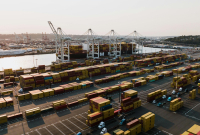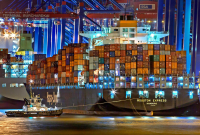Support strong Canadian climate journalism for 2025
Industry is the forgotten child of climate change mitigation, but a newly launched independent group — the Commission on Carbon Competitiveness — is aiming to change that in Canada.
We can’t address climate change without decarbonizing sectors like steel, cement, aluminum, oil & gas; they constitute a quarter of global emissions and over 40 per cent of Canada’s total. But relative to sectors like electricity and transport, which have clear routes to net-zero and have exponential rates of uptake worldwide — nearly one in five cars sold last year was electric, and annual growth of solar and wind generation is over seven per cent — industry is moving at a snail’s pace.
In part that’s because the technology pathways aren’t clear, though for many sectors they get clearer by the day. But it’s also because decarbonized production of these goods raises costs (at least for now), and in these heavily traded sectors that risks shifting emissions to countries that don’t have ambitious climate policies — a phenomenon known as carbon leakage.
The Commission’s first report finds risks of carbon leakage in nine sectors in Canada: iron and steel, aluminum, fertilizers, basic chemicals, cement, conventional oil and gas extraction, oil sands, pulp and paper and petroleum refining. But that risk varies across sectors with four sectors standing out as high-risk: iron and steel, chemicals, fertilizers, and pulp and paper (with cement close behind).
The Commission’s second report, launched with the first, zeros in on those high-risk sectors and asks what to do about that risk — how to remove leakage as a barrier to action? It evaluates the strengths and weaknesses of three policy tools.
One is border carbon adjustment. Now in force in the EU (and by 2027 in the UK), this is a charge at the border that levels the playing field — making imports pay for the carbon they entail as if they had been produced in Canada.
Canada wrapped up consultations in 2022 on what that might look like in this country. The EU’s model would not work well for Canada; given our heavy export pattern, it would need to also include a rebate of carbon costs at the point of export (similar to GST export rebates) to protect against leakage, but that option may be illegal under trade rules and risks weakening the incentives of the carbon price for Canadian producers.
Moreover, it would kick a hornet’s nest south of the border where most of those exports are sent. Realistically, a Canadian BCA would have to be designed as a cooperative effort with the US — not an easy challenge.
Another option is for Canada and trade partners, such as the US, to agree on prohibiting industrial products with embodied carbon above certain thresholds. This approach would protect against leakage within participating countries, though it would take time to negotiate.
Another option is the status quo. Canada’s existing industrial carbon pricing regimes (large emitter trading systems, or LETS) have built-in features to keep the average cost of carbon low — which reduces leakage risk — while still maintaining high costs at the margin, which motivates firms to decarbonize.
Typically, LETS employ a benchmark standard below which there’s no liability for carbon emissions; missing the standard means paying the headline carbon price, and beating it means credits that firms can sell to high emitters.
The report finds that in the short term — out to 2030 — it makes sense to use those benchmark standards to protect against leakage, but it recommends calibrating them heavily to the actual risk of leakage in each sector. In the high-risk sectors, the standard may need to be particularly generous.
In the medium term, though, as industries decarbonize, it becomes trickier to keep the market for credits in balance, and there’s a risk that policymakers will weaken climate policy to shy away from leakage risk. In fact, this may already be happening. So, we need to start now to explore how we could adapt border carbon adjustment or international standards to our needs.
Preventing carbon leakage isn’t the end of the story. For LETS to work, firms need certainty that carbon credits will be worth something in future, they need certainty that key inputs like low-carbon hydrogen and electricity will be available at scale, and they may need subsidies to defray the high costs of adopting low-carbon technologies that are not yet commercially proven.
The Commission reports end with a call to establish a high-level task force on carbon competitiveness to create tailored roadmaps of the policies and actions needed in each sector, and to begin to work cooperatively with the US and others on leakage prevention. The authors also recommend using Canada’s upcoming G7 Presidency to push for that kind of cooperation.
Getting this right is critical to Canada’s climate commitments, but also to ensuring that Canadian industry has a chance to compete in the global green markets of the future, where customers increasingly care about carbon embodied in traded goods and investors increasingly care about firms’ carbon footprints. It’s time to care for climate change’s forgotten child.
Aaron Cosbey is an economist with more than 30 years’ experience in the law and economics of sustainable development, in areas including trade, investment, mining, climate change, and green industrial policy. He is a senior associate with the International Institute for Sustainable Development.






Comments